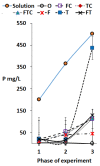Phosphorus Recovery from Sewage Sludge Using Acidithiobacilli
- PMID: 34281070
- PMCID: PMC8296893
- DOI: 10.3390/ijerph18137135
Phosphorus Recovery from Sewage Sludge Using Acidithiobacilli
Abstract
Sewage sludge contains a significant amount of phosphorus (P), which could be recycled to address the global demand for this non-renewable, important plant nutrient. The P in sludge can be solubilized and recovered so that it can be recycled when needed. This study investigated the P solubilization from sewage sludge using Acidithiobacillus thiooxidans and Acidithiobacillus ferrooxidans. The experiment was conducted by mixing 10 mL of sewage sludge with 90 mL of different water/liquid medium/inoculum and incubated at 30 °C. The experiment was conducted in three semi-continuous phases by replacing 10% of the mixed incubated medium with fresh sewage sludge. In addition, 10 g/L elemental sulfur (S) was supplemented into the medium in the third phase. The pH of the A. thiooxidans and A. ferrooxidans treated sludge solutions was between 2.2 and 6.3 until day 42. In phase 3, after supplementing with S, the pH of A. thiooxidans treated sludge was reduced to 0.9, which solubilized and extracted 92% of P. We found that acidithiobacilli supplemented with S can be used to treat sludge, i.e., achieve hygienization, removal of heavy metals, and solubilization and recovery of P.
Keywords: Acidithiobacillus ferrooxidans; Acidithiobacillus thiooxidans; bioleaching; phosphorus solubilization; recovery; sewage sludge.
Conflict of interest statement
The authors declare no conflict of interest.
Figures


References
-
- HELCOM Overview of Nutrient Recycling in the Baltic Sea Countries, HELCOM—2018. Baltic Marine Environment Protection Commission. [(accessed on 3 January 2021)]; Available online: https://helcom.fi/wp-content/uploads/2019/08/Overview-of-nutrient-recycl....
-
- Bhatti T.M., Yawar W. Bacterial solubilization of phosphorus from phosphate rock containing sulfur-mud. Hydrometallurgy. 2010;103:54–59. doi: 10.1016/j.hydromet.2010.02.019. - DOI
-
- Priha O., Sarlin T., Blomberg P., Wendling L., Mäkinen J., Arnold M., Kinnunen P. Bioleaching phosphorus from fluorapatites with acidophilic bacteria. Hydrometallurgy. 2014;150:269–275. doi: 10.1016/j.hydromet.2014.08.002. - DOI
-
- Calle-Castaneda S.M., Marquez-Godoy M.A., Hernandez-Ortiz J.P. Phosphorus recovery from high concentrations of low-grade phosphate rocks using the biogenic acid produced by the acidophilic bacteria Acidithiobacillus thiooxidans. Miner. Eng. 2018;115:97–105. doi: 10.1016/j.mineng.2017.10.014. - DOI
Publication types
MeSH terms
Substances
Supplementary concepts
LinkOut - more resources
Full Text Sources
Molecular Biology Databases

